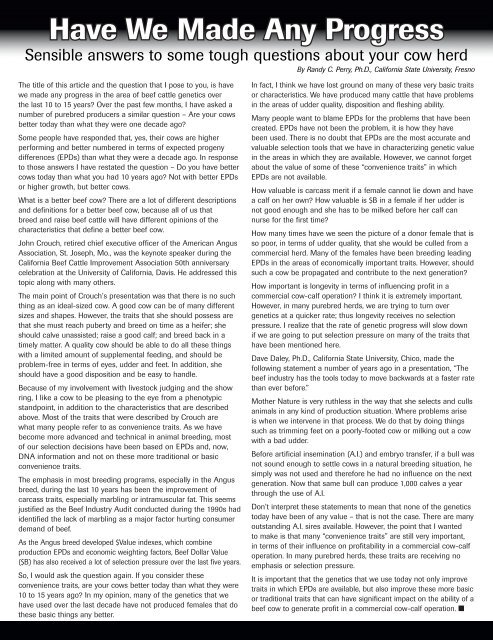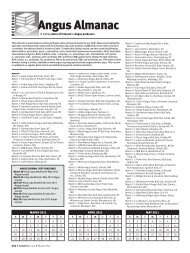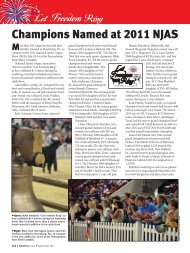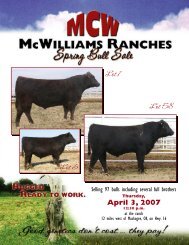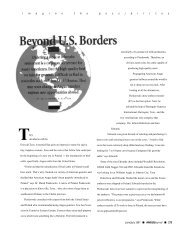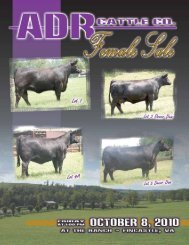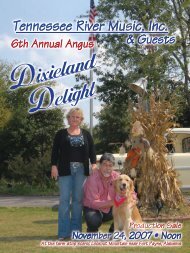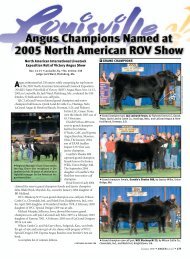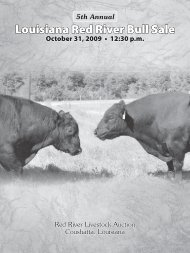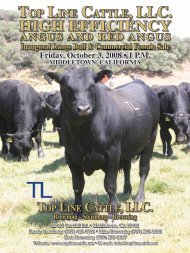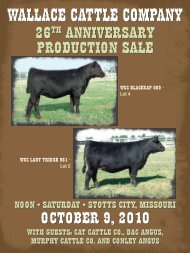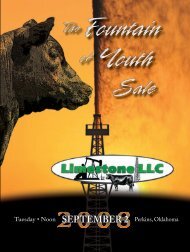Beef Genetic Management Guide - Angus Journal
Beef Genetic Management Guide - Angus Journal
Beef Genetic Management Guide - Angus Journal
Create successful ePaper yourself
Turn your PDF publications into a flip-book with our unique Google optimized e-Paper software.
Have We Made Any ProgressSensible answers to some tough questions about your cow herdBy Randy C. Perry, Ph.D., California State University, FresnoThe title of this article and the question that I pose to you, is havewe made any progress in the area of beef cattle genetics overthe last 10 to 15 years? Over the past few months, I have asked anumber of purebred producers a similar question – Are your cowsbetter today than what they were one decade ago?Some people have responded that, yes, their cows are higherperforming and better numbered in terms of expected progenydifferences (EPDs) than what they were a decade ago. In responseto those answers I have restated the question – Do you have bettercows today than what you had 10 years ago? Not with better EPDsor higher growth, but better cows.What is a better beef cow? There are a lot of different descriptionsand definitions for a better beef cow, because all of us thatbreed and raise beef cattle will have different opinions of thecharacteristics that define a better beef cow.John Crouch, retired chief executive officer of the American <strong>Angus</strong>Association, St. Joseph, Mo., was the keynote speaker during theCalifornia <strong>Beef</strong> Cattle Improvement Association 50th anniversarycelebration at the University of California, Davis. He addressed thistopic along with many others.The main point of Crouch’s presentation was that there is no suchthing as an ideal-sized cow. A good cow can be of many differentsizes and shapes. However, the traits that she should possess arethat she must reach puberty and breed on time as a heifer; sheshould calve unassisted; raise a good calf; and breed back in atimely matter. A quality cow should be able to do all these thingswith a limited amount of supplemental feeding, and should beproblem-free in terms of eyes, udder and feet. In addition, sheshould have a good disposition and be easy to handle.Because of my involvement with livestock judging and the showring, I like a cow to be pleasing to the eye from a phenotypicstandpoint, in addition to the characteristics that are describedabove. Most of the traits that were described by Crouch arewhat many people refer to as convenience traits. As we havebecome more advanced and technical in animal breeding, mostof our selection decisions have been based on EPDs and, now,DNA information and not on these more traditional or basicconvenience traits.The emphasis in most breeding programs, especially in the <strong>Angus</strong>breed, during the last 10 years has been the improvement ofcarcass traits, especially marbling or intramuscular fat. This seemsjustified as the <strong>Beef</strong> Industry Audit conducted during the 1990s hadidentified the lack of marbling as a major factor hurting consumerdemand of beef.As the <strong>Angus</strong> breed developed $Value indexes, which combineproduction EPDs and economic weighting factors, <strong>Beef</strong> Dollar Value($B) has also received a lot of selection pressure over the last five years.So, I would ask the question again. If you consider theseconvenience traits, are your cows better today than what they were10 to 15 years ago? In my opinion, many of the genetics that wehave used over the last decade have not produced females that dothese basic things any better.In fact, I think we have lost ground on many of these very basic traitsor characteristics. We have produced many cattle that have problemsin the areas of udder quality, disposition and fleshing ability.Many people want to blame EPDs for the problems that have beencreated. EPDs have not been the problem, it is how they havebeen used. There is no doubt that EPDs are the most accurate andvaluable selection tools that we have in characterizing genetic valuein the areas in which they are available. However, we cannot forgetabout the value of some of these “convenience traits” in whichEPDs are not available.How valuable is carcass merit if a female cannot lie down and havea calf on her own? How valuable is $B in a female if her udder isnot good enough and she has to be milked before her calf cannurse for the first time?How many times have we seen the picture of a donor female that isso poor, in terms of udder quality, that she would be culled from acommercial herd. Many of the females have been breeding leadingEPDs in the areas of economically important traits. However, shouldsuch a cow be propagated and contribute to the next generation?How important is longevity in terms of influencing profit in acommercial cow-calf operation? I think it is extremely important.However, in many purebred herds, we are trying to turn overgenetics at a quicker rate; thus longevity receives no selectionpressure. I realize that the rate of genetic progress will slow downif we are going to put selection pressure on many of the traits thathave been mentioned here.Dave Daley, Ph.D., California State University, Chico, made thefollowing statement a number of years ago in a presentation, “Thebeef industry has the tools today to move backwards at a faster ratethan ever before.”Mother Nature is very ruthless in the way that she selects and cullsanimals in any kind of production situation. Where problems ariseis when we intervene in that process. We do that by doing thingssuch as trimming feet on a poorly-footed cow or milking out a cowwith a bad udder.Before artificial insemination (A.I.) and embryo transfer, if a bull wasnot sound enough to settle cows in a natural breeding situation, hesimply was not used and therefore he had no influence on the nextgeneration. Now that same bull can produce 1,000 calves a yearthrough the use of A.I.Don’t interpret these statements to mean that none of the geneticstoday have been of any value – that is not the case. There are manyoutstanding A.I. sires available. However, the point that I wantedto make is that many “convenience traits” are still very important,in terms of their influence on profitability in a commercial cow-calfoperation. In many purebred herds, these traits are receiving noemphasis or selection pressure.It is important that the genetics that we use today not only improvetraits in which EPDs are available, but also improve these more basicor traditional traits that can have significant impact on the ability of abeef cow to generate profit in a commercial cow-calf operation. n


